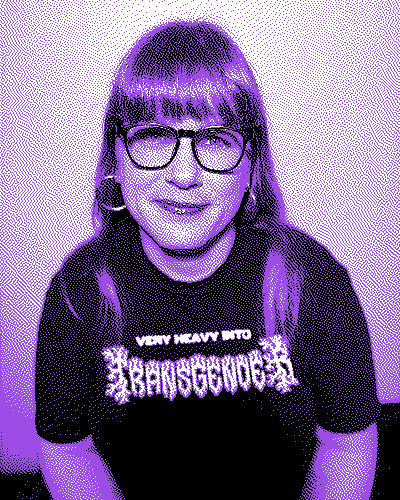
Bio
Chelsea Thompto (she/her) is a transdisciplinary artist and
educator working at the intersections of art, trans studies, and
technology. Her research based studio practice spans a variety of
media which often include code, video, sound, writing, and
sculpture and her work has been shown nationally and
internationally. Born and raised in Iowa, she has spent most of
her life between the Midwest and California and is now an
Assistant Professor of Creative Technologies at Virginia Tech and
serves as the Executive Editor of
Media-N: Journal of the New Media Caucus. She received an MFA in 4D Art and an MA in Gender and Women's
Studies from the University of Wisconsin Madison.
Curriculum Vitae
Environmental Responsibility Statement
Artist Statement
In my art practice, I am animated by questions. Questions drive my research, which ultimately drives my making. Some notable questions that have driven my studio work in recent years include:
- Who made the river a cyborg?
- What would happen if the spine of a book was a point rather than a line?
- As a trans person, is it better to be seen accurately, or not seen at all?
- Can fog be an aspirational figure for trans embodiment and resistance?
Through questions like these, I begin to create the objects, scenes,
and interactions that form the basis of new works. These questions
stem from an ongoing fixation with the politics of visibility, and my
lived experience as a transwoman in the United States. More
specifically, I am focused on the trans body as a site of contemporary
productions of the inhuman, and of violence (physical, emotional,
institutional, and otherwise) committed in the ongoing effort to reify
gender as a binary system. My practice is centered around a critical
engagement with current and historical systems of codification and
control, to draw the viewer into an affective exploration of what it
means to inhabit a fluid body subjected to colonial logics of
visualization meant to fix, delineate, and stabilize. The imagery
generated by and surrounding these systems is co-opted and enfolded
into the work itself, to interrogate the types of knowledge they
produce.
I am deeply invested in material specificity, leveraging the inherent
qualities (which are always contested and culturally situated) of
materials is a central part of my practice. With technical knowledge
that includes code, video, digital fabrication, traditional sculptural
processes, writing, and bookbinding, I move works across and through
different materials and processes to explore their formal and
conceptual potential. This process enacts “trans-” as a tactic and
gesture for art making. This movement of ideas across the through
materials fundamentally changes my relationship to the material from a
fixed understanding of “material as meaning” towards a more fluid
understanding of “material as lens or framework”. Within this
transdisciplinary approach, intricate systems are employed to create
visual form, articulate data, and allude to our habitual ordering of
people and behaviors.
Throughout my art making and writing, I am drawn towards producing
work that challenges the harmful systems and paradigms that currently
threaten trans folks, and have begun to move towards production that
imagines more livable futures for trans people. I believe that any
future facing work must acknowledge our climate crisis. To this end, I
have begun to engage more directly with the ways our relationships to
art and technology impact our climate future, and how we might rethink
these relationships moving forward. These engagements have impacted my
material choices in the studio, and the logistical considerations of
my intellectual production and professional practice as a whole.
About This Site
This site was designed and coded by Chelsea with the following things
in mind. First, the site does not track or collect user data in any
way,
this is a good article
about why this is important by the LA Times, it covers cookies and
data privacy. Second, the site is designed to run as efficiently as
possible and to only serve high quality images and videos when you
arrive at pages related to specific projects as a method of reducing
the overall environmental impact of the site. This is why you will see
dithered images
on many pages (including this one) in place of standard images. This
effort is guided by the ideas laid out in the
Sustainable Web Manifesto
and the accompanying resource
https://sustainablewebdesign.org/.
This site uses the
Red Hat Text
font by
MCKL. Dithering was done using the online tool
Dither Me This.